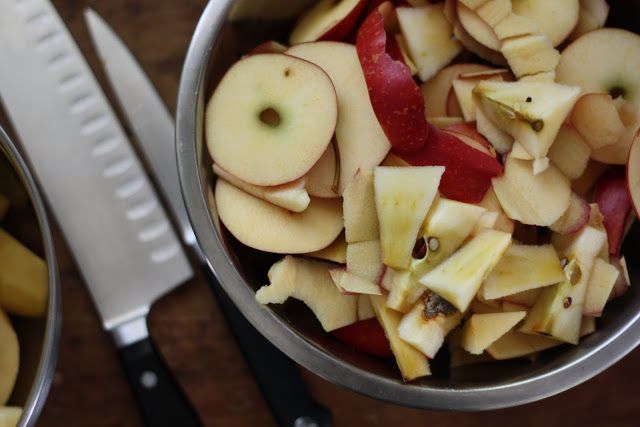How to Make Apple Vinegar

Apple vinegar has been hailed as a cure-all dietary supplement, with health benefits ranging from allergy relief to fat-burning. The research supports some of these claims to a degree, but there is still work to be done.
Myths and Facts — Health Benefits of Apple Vinegar
Here’s what we know for sure, according to Alexa Schmitt, a clinical dietitian at Massachusetts General Hospital:
- Weight loss. Sorry, but there is no scientific evidence to suggest that apple cider vinegar can affect metabolism, which is the way your body breaks down food and burns calories. Apple vinegar itself is very low in calories — just 25 in a whole cup — so substituting it for creamy salad dressings will help you lose weight naturally.
- Cholesterol. A study done on rats (not yet on humans) that were put on a diet with an acetic acid supplement had lower cholesterol levels than rats not given the supplement. Acetic acid is present in apple vinegar.
- Diabetes/high blood sugar. Recent scientific investigations have shown that vinegar ingestion reduces blood sugar levels in individuals with Type 2 diabetes and insulin-resistance. (The National Institutes of Health)
- Calcium absorption. Acetic acid, like other acids, can increase the body’s absorption of essential minerals from food — including calcium, the body’s #1 osteoporosis-fighter. Add a splash of vinegar to your vegetables/salad or fruit juice (you won’t taste it) to help your body absorb locked-away minerals. A great alternative for the lactose-intolerant.
- Blood pressure. Apple vinegar indirectly helps lower blood pressure if you use it as a condiment instead of oil-heavy salad dressing and/or salt.
- Inflammation. Researchers are discovering more information about the damage an inflammatory diet can cause to joints, organs, brain proteins and skin. Most Americans eat a highly inflammatory diet, which creates an acidic body pH. Ingesting a tablespoon of vinegar each day can help re-balance your pH and reduce inflammation.
Uses for Apple Vinegar
Apple vinegar has the tart tang you’d expect, but there is also a pleasant sweet edge, as many fruit vinegars have. It’s that balance that makes it a flavor-booster for so many dishes. Apple vinegar also has a few hundred others uses, some of which are noted below.

- Improve the flavor of steamed vegetables and fresh fruit (especially berries)
- Perk up bean soup, refried beans or other cooked beans
- Add flakiness to your pie crust
- Enhance the natural sweetness of fruit juice
- Substitute for salt (except in baking), ketchup and lemon juice
- Make vinaigrette instead of a mayo-based dressing for salad greens or coleslaw (equal parts vinegar, water/fruit juice and oil, with a pinch each of Dijon mustard and black pepper, and chopped herbs of your choice). If you haven’t yet tried vinaigrette on a sandwich instead of mayonnaise, you’ll be pleased with the result.
- Marinate poultry, pork or beef; it tenderizes and deeply flavors meat
- Make a solution of 9-parts water to 1-part apple vinegar to dissolve pesticides and bacteria from your produce. Just swish the produce in the solution and rinse off with clear water. Do not use this solution on berries, as they are too fragile.
- Dab on bug bites and sunburn to soothe the itch/sting
- Rinse your hair after shampooing, to add shine and remove residue
- Tone your skin and reduce oiliness (use 1 part each vinegar and water)
- Safely damp-mop hardwood floors (use ¼ c. vinegar to 1 gal. water)

Apple Vinegar Recipe
Three ingredients, virtually no measuring, proven health benefits… and the perfect way to use up every apple scrap in your abundant harvest. The next time you’re using up your apple crop to make pies, juice or sauce, be sure to save all the scraps — bits, peels and cores — and make some homemade apple vinegar. It’s super-easy, no cooking is required and you can multiply the recipe for as many apple scraps as you have.

Let's make some apple vinegar!
You will need:
- Apple scraps from 1 bushel of apples
- 2 Tablespoons sugar
- Water
- Canning jars, lids and rings
- Cheesecloth (cut into) squares that fully cover the jar opening

Directions:
- Place your scraps in a large, non-corrosive container (ceramic, stone or glass). You may need multiple containers depending upon the size of your batch. If you’re picking apples over several days, just accumulate the scraps in your container until you have enough. It’s fine if they turn brown.
- Add just enough water to cover the scraps by 2 inches, and add the sugar. Stir.
- Cover with a plate to fit inside the opening, and weigh it down with a clean brick or small bowl filled with water. Cover the whole arrangement with a kitchen towel.
- Let it sit, unrefrigerated, for one week. Some mold will form on the top of the liquid, but that’s expected. Just skim it off with a serving spoon and discard it.
- Strain the apple scraps through a fine sieve into a canning jar. It will be a bit cloudy; what you see is the “mother” vinegar. (Side note: “Mothers” can be used to “start” more vinegar, the same way a sourdough starter can be used to ferment more bread dough. There are mother vinegars that have been passed down through generations… some are centuries old!)
- If you want perfectly clear vinegar, put a coffee filter in your sieve.
- Lay a square of cheesecloth over the jar opening, and then place the lid and ring on the jar. The cheesecloth will prevent the metal lid from corroding. Store the jars in your pantry for 6 weeks to let the vinegar mellow. Its high acidity makes it self-preserving; no refrigeration is needed, and it will keep virtually forever. If the vinegar becomes cloudier/and or sediment forms on the bottom, just strain it out. It is not harmful nor does it indicate that the vinegar has "spoiled".
This information is solely for informational purposes. IT IS NOT INTENDED TO PROVIDE MEDICAL ADVICE. The publication of this information does not constitute the practice of medicine, and this information does not replace the advice of your physician or other health care provider. Before undertaking any course of treatment, the reader must seek the advice of their physician or other health care provider.
Photo credit: Tim and Mary Vidra


